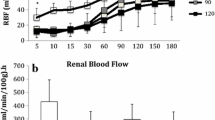Abstract
This study was designed to verify the effect of reperfusion of donor hearts in a perfusion apparatus after 60 min of global ischemia prior to heart transplantation. Thirteen dogs were exsanguinated from the femoral artery and cardiac arrest was achieved. The hearts were left in situ at room temperature (25°C)for 60 min. In group A (n=7), the hearts were excised and reperfused 60 min after cardiac arrest in the perfusion apparatus with substrate-enriched warm blood cardioplegia (WBCP) containing a hydroxyl radical scavenger, EPC, followed by 45 min of blood perfusion, Next, the hearts were preserved in cold (4°C) University of Wisconsin (UW) solution. In group B (n=6), the hearts were perfused with cold (4°C) St. Thomas' solution 60 min after cardiac arrest and preserved in cold UW solution. Thereafter, all hearts in both groups were transplanted orthotopically to recipient dogs. In group A, 6 of 7 dogs were weaned from cardiopulmonary bypass (CPB). In group B, only 2 of 6 dogs were weaned from CPB. Moreover, 3 of the 6 hearts in group B did not start beating after transplantation (stone heart). This study suggested reperfusion of the donor heart in the perfusion apparatus with WBCP to be a beneficial preconditioning method when utilizing 60-min arrested hearts for transplantation.
Similar content being viewed by others
References
Hosenpud JD, Bennett LE, Keck BM, Fiol B, Novick RJ (1997) The Registry of the International Society for Heart and Lung Transplantation: fourteenth official report—1997. J Heart Lung Transplant 16:691–712
Wuerflein RD, Shumway NE (1967) Resuscitation and function of the cadaver heart. Circulation 35 (Suppl 1):92–95
Gundry SR, Fukushima N, Eke CC, Hill AC, Zuppan C, Bailey LL (1995) Successful survival of primates receiving transplantation with “dead” nonbeating donor hearts. J Thorac Cardiovasc Surg 109:1097–1102
Shirakura R, Matsuda H, Nakano S, Nakata S, Kaneko M, Miyamoto Y, Matsuwaka R, Kitagawa S, Fukushima N, Kawashima Y (1992) Cardiac function and myocardial performance of 24-hour-preserved asphyxiated canine hearts. Ann Thorac Surg 53:440–444
Morimoto T, Hisamochi K, Teramoto S (1993) Transplantation of the canine cadaver heart using a core-cooling technique. Acta Med Okayama 47:199–207
Takagaki M, Hisamochi K, Morimoto T, Bando K, Sano S, Shimizu N (1996) Successful transplantation of cadaver hearts harvested one hour after hypoxic cardiac arrest. J Heart Lung Transplant 15:527–531
Hisamochi K, Morimoto T, Bando K, Senoo Y, Teramoto S (1997) A new hydroxyl radical scavenger “EPC” on cadaver heart transplantation in a canine model. Surg Today 27:930–935
Patterson SW, Starling EH (1914) On the mechanical factors which determine the output of the ventricles. J Physiol 48:357–379
Robicsek F (1996) Cadaver hearts as donor grafts. Transplant Int 9:438
Hansen PL, Schilt W, Heitmann L, Oroz M, Buchler A, Lemeunier A (1971) Influence of the agonal period on the postmortem metabolic state of the heart. A problem in cardiac preservation. Ann Surg 174:744–754
Lazar HL, Buckberg GD, Manganaro AM, Becker H (1980) Myocardial energy replensihment of ischemic damage by substrate enhancement of secondary blood cardioplegia with amino acids during reperfusion. J Thorac Cardiovasc Surg 80:350–359
Shirakura R, Hinose H, Matsuda H, Nakano S, Nakata S, Ohtani M, Kawaguti A, Miyagawa S, Takami H, Naka Y, Kawashima Y (1989) Resuscitation and preservation of agonally arrested hearts for transplantation: a study of 24 hour stored canine hearts. Transplant Proc 21:1347–1349
Takagaki M, Hisamochi K, Morimoto T, Bando K, Sano S, Shimizu N (1996) Transplantation of the cadaver heart harvested one hour after hypoxic cardiac arrest using the core-cooling technique in dogs. Acta Med Okayama 50:17–24
Gaasch WH, Bing OHL, Pine MB, Franklin A, Clement J, Rhodes D, Phear WP, Weintraub RM (1978) Myocardial contracture during prolonged ischemic arrest and reperfusion. Am J Physiol 235:H619-H627
Kevelaitis E, Mouas C, Menasche P (1996) Poststorage diastolic abnormalities of heart transplants: is vascular dysfunction or myocardial contracture the culprit? J Heart Lung Transplant 15:461–469
Ogata K, Yamamoto K, Tsuruoka H (1990) Chemical structure and physiochemical properties of L-ascorbic acid 2-(3,4-dihydro-2,5,7,8-tetramethyl-2-(4,8,12-trimethyltridecyl)-2H-1-benzopyran-6-yl hydrogen) potassium salt (EPC-K1). Iyakuhin Kenkyu (Med Drugs Res) 21:222–228
Mori A, Edamatsu R, Kohno M, Ohmori S (1989) A new hydroxyl radical scavenger: EPC-K1. Neurosciences 48:371–376
Inoue M (1997) Effect of phosphate diester linkage of vitamin E and vitamin C (EPC-K1) on myocardial ischemia/reperfusion injury in the isolated working rat heart. J Jpn Assoc Thorac Surg 45:742–749
Author information
Authors and Affiliations
Additional information
This study was supported in part by Senju Pharmaceutical Co. Ltd., Osaka, Japan
Rights and permissions
About this article
Cite this article
Suehiro, K., Mohri, M., Takagaki, M. et al. The effect of graft perfusion with warm blood cardioplegia for cadaver heart transplantation. Surg Today 29, 890–896 (1999). https://doi.org/10.1007/BF02482781
Received:
Accepted:
Issue Date:
DOI: https://doi.org/10.1007/BF02482781




